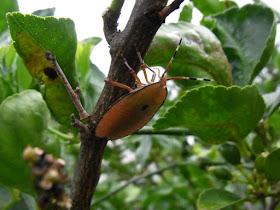Sunday, October 28, 2012
Little suckers
Amid all the lovely surprises which keep me constantly fascinated here, the other side of the coin is that gardening is full of its annual and seasonal rituals, both good and bad. This morning we staged the Festival of the Stink Bugs, only slightly less dangerous than running with the bulls in Pamplona, and probably just as smelly.
Now, light infestations of this pest aren't so bad and you can ignore them if you like, but also at your peril, as heavy infestations can develop rapidly, which is why I get onto them as soon as I see them.
Wherever possible, I try to do everything the organic way in my garden, especially with food plants, but if that's not possible I then go for the least bad option. Most of the time I never reach into the 'least bad' bin of ideas, but for bronze orange bugs I do. Here's why...
One organic control for these pests is to physically knock them off the tree and drop them into a bucket of very hot water. That, my friends, is easier said than done! My lime tree is spiny, so it's not a great venue for bug whacking with a stick. And a precision bug whacker is needed to get them all. In many cases they just fall further down the tree and understandably try to hide. Getting up close to these bugs is also hazardous: they squirt an evil smelling spray when attacked (hence the name 'stink bug') and doing combat with them requires goggles and protective clothing, so the citrus spines don't make you look like an overly keen Easter crucifixion re-enactor. I have tried this 'knock them off' method but sorry, never again.
Another commonly mentioned organic control is even more impractical than precision whacking. It's suggested you use a vacuum cleaner to suck the little suckers off the tree. Oh great! Even if it works (and I have my doubts... have they thought through the practicalities of outdoor vacuuming of spiny trees, really??) your vacuum cleaner ends up smelling like a high school chemistry lab disaster. Sorry, not my Dyson!
And so, alas, it's off to the 'least bad' bin for a solution. And it's not so bad, either. Pyrethrum spray does the trick. This is the spray made from chemicals which naturally occur in certain daisy-family flowers. I just zap the individual bugs with it, not the whole tree. Even if you sprayed the whole tree (which would be a seriously dumb thing for a backyard gardener with one tree to do) the 'withholding period' with pyrethrum is just one day. In zapping a dozen or so bugs I reckon I sprayed about 2% of the tree, max.
And pyrethrum works. Some stink bugs succumb quickly to it, others take a few minutes to drop off the peg.
And so the moral of this story is this: if you have a backyard citrus tree in Australia, go outside and check it for bronze orange bugs now. October-November is the peak season for them. I'll leave the business of what you do next up to you.


I've spent quite a bit of time over the weekend getting rid of these smelly little critters. I don my gloves, bucket of boiling water, grab each one and throw it in. Seems like a quick death. I find that I have to do a few 20 minute sessions over a couple of weeks to get rid of them completely.
ReplyDeleteMaybe I should give that another go, but my earlier attempts were painful, mostly because the stink bugs really like my lime tree. They seem to leave the Eureka lemon and Thai lime alone, and just congregate in the thorny little espaliered Tahitian lime.
ReplyDeleteYou're an organic best practice role model, Lanie, I'm inspired!
I have not seen anything like this on my "only" 1 year old citrus tree. Or the little suckers wait for it to grow bigger with enough sap to suck!
ReplyDeleteI have an enormous 60 odd year old orange tree and stink bugs are the bane of my life. I've spent many many hours picking the b****rs off one by one and either feeding them to the chooks or dropping them into buckets of scalding hot water.
ReplyDeleteThe horrible liquid they produce can stain your fingers brown for days even if you are wearing gloves.
I often wonder if the eggs will taste horrible after the chooks have eaten the disgusting things.
Thank you greenfumb, I have now solved the mystery as to why I have brown stains on my fingers! Not sure about best practice role model Jamie, especially since I really only have 4 small citrus trees. And now I know that pyrethrum works I will give it a go!
ReplyDeleteLooks lovely - glad we don't have them.
ReplyDeleteOh yes, it's that time of year again. Very tedious. Stinkbug haters unite! Here's my thoughts on an earlier blog post: http://ambradambra.wordpress.com/2012/07/18/the-revenge-of-the-mandarin-stinkbugs-or-how-i-learned-to-love-the-broom/
ReplyDelete